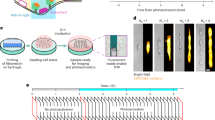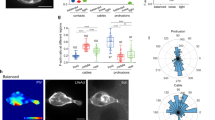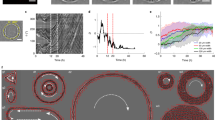Abstract
The leading front of a collectively migrating epithelium often destabilizes into multicellular migration fingers where a cell initially similar to the others becomes a leader cell while its neighbours do not alter. The determinants of these leader cells include mechanical and biochemical cues, often under the control of small GTPases. However, an accurate dynamic cartography of both mechanical and biochemical activities remains to be established. Here, by mapping the mechanical traction forces exerted on the surface by MDCK migration fingers, we show that these structures are mechanical global entities with the leader cells exerting a large traction force. Moreover, the spatial distribution of RhoA differential activity at the basal plane strikingly mirrors this force cartography. We propose that RhoA controls the development of these fingers through mechanical cues: the leader cell drags the structure and the peripheral pluricellular acto-myosin cable prevents the initiation of new leader cells.
This is a preview of subscription content, access via your institution
Access options
Subscribe to this journal
Receive 12 print issues and online access
$209.00 per year
only $17.42 per issue
Buy this article
- Purchase on SpringerLink
- Instant access to full article PDF
Prices may be subject to local taxes which are calculated during checkout






Similar content being viewed by others
Change history
26 February 2014
In the version of this Article originally published there were some errors. All these errors have been corrected in the online versions of the Article.
References
Wood, W. et al. Wound healing recapitulates morphogenesis in Drosophila embryos. Nat. Cell Biol. 4, 907–912 (2002).
Poujade, M. et al. Collective migration of an epithelial monolayer in response to a model wound. Proc. Natl Acad. Sci. USA 104, 15988–15993 (2007).
Rørth, P. Collective guidance of collective cell migration. Trends Cell Biol. 17, 575–579 (2007).
Friedl, P., Locker, J., Sahai, E. & Segall, J. E. Classifying collective cancer cell invasion. Nat. Cell Biol. 14, 777–783 (2012).
Omelchenko, T., Vasiliev, J. M., Gelfand, I. M., Feder, H. H. & Bonder, E. M. Rho-dependent formation of epithelial ‘leader’ cells during wound healing. Proc. Natl Acad. Sci. USA 100, 10788–10793 (2003).
Vitorino, P. & Meyer, T. Modular control of endothelial sheet migration. Genes Dev. 22, 3268–3281 (2008).
Friedl, P. & Gilmour, D. Collective cell migration in morphogenesis, regeneration and cancer. Nat. Rev. Mol. Cell Biol. 10, 445–457 (2009).
Hegerfeldt, Y., Tusch, M., Bröcker, E. & Friedl, P. Collective cell movement in primary melanoma explants?: plasticity of cell–cell interaction, β1-integrin function, and migration strategies. Cancer Res. 62, 2125–2130 (2002).
Lim, J. I., Sabouri-Ghomi, M., Machacek, M., Waterman-Storer, C. M. & Danuser, G. Protrusion and actin assembly are coupled to the organization of lamellar contractile structures. Exp. Cell Res. 316, 2027–2041 (2010).
Khalil, A. A. & Friedl, P. Determinants of leader cells in collective cell migration. Integr. Biol. 2, 568–574 (2010).
Mark, S. et al. Physical model of the dynamic instability in an expanding cell culture. Biophys. J. 98, 361–370 (2010).
Trepat, X. et al. Physical forces during collective cell migration. Nat. Phys. 5, 426–430 (2009).
Tambe, D. T. et al. Collective cell guidance by cooperative intercellular forces. Nat. Mater. 10, 469–475 (2011).
Reffay, M. et al. Orientation and polarity in collectively migrating cell structures: statics and dynamics. Biophys. J. 100, 2566–2575 (2011).
Ridley, A. J. Life at the leading edge. Cell 145, 1012–1022 (2011).
Pertz, O., Hodgson, L., Klemke, R. L. & Hahn, K. M. Spatiotemporal dynamics of RhoA activity in migrating cells. Nature 440, 1069–1072 (2006).
Kaunas, R., Nguyen, P., Usami, S. & Chien, S. Cooperative effects of Rho and mechanical stretch on stress fiber organization. Proc. Natl Acad. Sci. USA 102, 15895–15900 (2005).
Theveneau, E. et al. Collective chemotaxis requires contact-dependent cell polarity. Dev. Cell 19, 39–53 (2010).
Wang, X., He, L., Wu, Y. I., Hahn, K. M. & Montell, D. J. Light-mediated activation reveals a key role for Rac in collective guidance of cell movement in vivo. Nat. Cell Biol. 12, 591–597 (2010).
Gaggioli, C. et al. Fibroblast-led collective invasion of carcinoma cells with differing roles for RhoGTPases in leading and following cells. Nat. Cell Biol. 9, 1392–1400 (2007).
Omelchenko, T. & Hall, A. Myosin-IXA regulates collective epithelial cell migration by targeting RhoGAP activity to cell–cell junctions. Curr. Biol. 22, 278–288 (2012).
Du Roure, O. et al. Force mapping in epithelial cell migration. Proc. Natl Acad. Sci. USA 102, 2390–2395 (2005).
Aoki, K. & Matsuda, M. Visualization of small GTPase activity with fluorescence resonance energy transfer-based biosensors. Nat. Protoc. 4, 1623–1631 (2009).
Burnette, D. T. et al. A role for actin arcs in the leading-edge advance of migrating cells. Nat. Cell Biol. 13, 371–381 (2011).
Farooqui, R. & Fenteany, G. Multiple rows of cells behind an epithelial wound edge extend cryptic lamellipodia to collectively drive cell-sheet movement. J. Cell Sci. 118, 51–63 (2005).
Saez, A., Buguin, A., Silberzan, P. & Ladoux, B. Is the mechanical activity of epithelial cells controlled by deformations or forces?. Biophys. J. 89, L52-4 (2005).
Dembo, M. & Wang, Y.-L. Stresses at the cell-to-substrate interface during locomotion of fibroblasts. Biophys. J. 76, 2307–2316 (1999).
Galbraith, C. G. & Sheetz, M. P. Keratocytes pull with similar forces on their dorsal and ventral surfaces. J. Cell Biol. 147, 1313 –1323 (1999).
Fournier, M. F., Sauser, R., Ambrosi, D., Meister, J.-J. & Verkhovsky, A. B. Force transmission in migrating cells. J. Cell Biol. 188, 287–297 (2010).
Klarlund, J. K. Dual modes of motility at the leading edge of migrating epithelial cell sheets. Proc. Natl Acad. Sci. USA 109, 15799–15804 (2012).
Kumar, S. et al. Viscoelastic retraction of single living stress fibers and its impact on cell shape, cytoskeletal organization, and extracellular matrix mechanics. Biophys. J. 90, 3762–3773 (2006).
Hutson, M. S. et al. Forces for morphogenesis investigated with laser microsurgery and quantitative modeling. Science 300, 145–149 (2003).
Kurokawa, K. & Matsuda, M. Localized RhoA activation as a requirement for the induction of membrane ruffling. Mol. Biol. Cell 16, 4294–4303 (2005).
Eichorst, J. P., Lu, S., Xu, J. & Wang, Y. Differential RhoA dynamics in migratory and stationary cells measured by FRET and automated image analysis. PLoS One 3, e4082 (2008).
Machacek, M. et al. Coordination of Rho GTPase activities during cell protrusion. Nature 461, 99–103 (2009).
El-Sibai, M. et al. RhoA/ROCK-mediated switching between Cdc42- and Rac1-dependent protrusion in MTLn3 carcinoma cells. Exp. Cell Res. 314, 1540–1552 (2008).
Tamada, M., Perez, T. D., Nelson, W. J. & Sheetz, M. P. Two distinct modes of myosin assembly and dynamics during epithelial wound closure. J. Cell Biol. 176, 27–33 (2007).
Vaezi, A., Bauer, C., Vasioukhin, V. & Fuchs, E. Actin cable dynamics and Rho/Rock orchestrate a polarized cytoskeletal architecture in the early steps of assembling a stratified epithelium. Dev. Cell 3, 367–381 (2002).
Hidalgo-Carcedo, C. et al. Collective cell migration requires suppression of actomyosin at cell–cell contacts mediated by DDR1 and the cell polarity regulators Par3 and Par6. Nat. Cell Biol. 13, 49–58 (2010).
Zhao, X.-H. et al. Force activates smooth muscle alpha-actin promoter activity through the Rho signaling pathway. J. Cell Sci. 120, 1801–1809 (2007).
Lessey, E. C., Guilluy, C. & Burridge, K. From mechanical force to RhoA activation. Biochemistry 51, 7420–7432 (2012).
Bellusci, S., Moens, G., Thiery, J.-P. & Jouanneau, J. A scatter factor-like factor is produced by a metastatic variant of a rat bladder carcinoma cell line. J. Cell Sci. 107, 1277–1287 (1994).
Yamada, S., Pokutta, S., Drees, F., Weis, W. I. & Nelson, W. J. Deconstructing the cadherin-catenin-actin complex. Cell 123, 889–901 (2005).
Itoh, R. E. et al. Activation of rac and cdc42 video imaged by fluorescent resonance energy transfer-based single-molecule probes in the membrane of living cells. Mol. Cell. Biol. 22, 6582–6591 (2002).
Yoshizaki, H. et al. Activity of Rho-family GTPases during cell division as visualized with FRET-based probes. J. Cell Biol. 162, 223–232 (2003).
Ghibaudo, M. et al. Traction forces and rigidity sensing regulate cell functions. Soft Matter 4, 1836–1843 (2008).
Hodgson, L., Nalbant, P., Shen, F. & Hahn, K. M. Imaging and photobleach correction of Mero-CBD, sensor of endogenous Cdc42 activation. Methods Enzymol. 406, 140–156 (2006).
Supatto, W. et al. In vivo modulation of morphogenetic movements in Drosophila embryos with femtosecond laser pulses. Proc. Natl Acad. Sci. USA 102, 1047–1052 (2005).
Rasband, W.S. ImageJ v1.46b (US National Institutes of Health, Bethesda, (1997–2012).
Deforet, M. et al. Automated velocity mapping of migrating cell populations (AVeMap). Nat. Methods 9, 1081–1083 (2012).
Petitjean, L. et al. Velocity fields in a collectively migrating epithelium. Biophys. J. 98, 1790–1800 (2010).
Acknowledgements
It is a pleasure to thank G. Duclos for his help in several experiments, the members of the Biology-Inspired Physics at Mesoscales group and D. Louvard (Institut Curie) for discussions and support, M. Matsuda (Kyoto University) for sharing with us the FRET plasmids and for a critical analysis of our data, and W. J. Nelson (Stanford University) for the GFP-modified cell lines. We thank the Institut Curie-CNRS Nikon Imaging Center and the BDD imaging centre and particularly V. Fraisier, O. Leroy and L. Sengmanivong for technical support. We gratefully acknowledge financial support from the C’nano Ile de France, the Association Christelle Bouillot, the Association pour la Recherche sur le Cancer, the Labex CelTisPhyBio and the Institut Curie Programme Incitatif et Coopératif ‘Physique de la Cellule’.
Author information
Authors and Affiliations
Corresponding authors
Ethics declarations
Competing interests
The authors declare no competing financial interests.
Integrated supplementary information
Supplementary Figure 1 Migration fingers respond to the micropillar array rigidity.
(A) Experimental set-up. The microstencil is deposited on the surface; cells are then seeded and cultured until confluence in the apertures. Peeling off the stencil triggers cell migration on the free surface. (B) Fingers develop well on a micropillar array. Phase contrast image of the migrating front on a micropillar array. The fingers are clearly identified. They are preceded by a leader cell of a specific phenotype. Representative image, more than 20 replicates. (C-D) Influence of the substrate rigidity on the force profile. (C) Forces were measured on substrates differing on the height of the pillars and hence on their effective rigidity (see Material and Methods). The absolute forces were very different. (D) In contrast, the deflection of the pillars does not depend on their rigidity (i. e. the forces are proportional to the surface rigidity). 5 μm high pillars correspond to an effective Young Modulus of 1.7 kPa; 3 μm high pillars correspond to an effective Young modulus of 7.8 kPa−1. 5μm-pillars: n = 10 fingers from 3 independent experiments; 3μm-pillars: n = 9 fingers from 3 independent experiments. Error bars are SEMs.
Supplementary Figure 2 The peripheral actin cable is under tension and interacts directly with the substrate.
(A) Image sequence following the severing of the actin-GFP cable by photoablation (scale bar 10μm). The white arrow indicates the initial ablation. The solid triangles denote the extremities of the retracting cable (see also Supplementary Movie 1). Note that small structures next to the cable retract as well (empty triangle), demonstrating that this is a tension driven relaxation. Representative images. More than 20 replicates. (B) Distance between the two extremities of the cable as a function of time. The cyan line is the average of the different independent measurements (black curves), yielding a characteristic time of 37 ± 7 s (SD) after a fit by an exponential function. The orange area is the standard deviation over 20 experiments. (C) When cut by photoablation (top panel, arrow), not only the forces at the cut relax but also the neighboring pillars situated under the cable. t = 0 is the time of ablation. Top panel = actin-GFP and pillars bottom panel = local forces (colours give the intensity and arrows the direction). The white triangles denote the high forces at pillars next to the cut. Note that the relaxation at longer times involves more pillars at a distance from the physical cut which demonstrates the direct interaction of the tensile actin cable with the substrate. Representative image. 20 replicates.
Supplementary Figure 3 Forces and RhoA distribution evolve with similar kinetics.
(A) Successive force profiles acquired after finger onset. t = 0 represent the onset of the finger as visually determined. The profiles at early times are of smaller amplitude and shifted closer to the epithelium. (B) Dynamic evolution of the force measured at the tip (coincides with the maximal force) for 3 fingers assessed from 3 independent experiments (one colour stands for one finger), the line is an exponential fit of all the data. Error bars are the experimental absolute uncertainty. (C) Representative cell becoming a leader within the epithelium (left), at the onset of the finger (center) and when the finger is fully developed (right). The gradient of RhoA activity in the leader cell sets up at similar time scales at the onset of a finger. Representative image. 3 replicates.
Supplementary Figure 4 Fingers are under RhoA control.
(A) Use of chemical inhibitors. The drugs were used either at the beginning of the experiments or 4–6 hours after stencil removal to highlight their action on finger formation or on their maintenance. Leaders are identified by their phenotype (larger cells, active ruffling lamellipodium). Bars are 250 m. n = 6 independent experiments. Errors are SEMs. (B) Validation of anti-RhoA siRNAs. Western blots anti-Rac1 and anti-RhoA were performed on lysates of MDCK cells not-transfected or treated with control siRNA, siRhoA#1 or siRhoA#2. Expression levels were normalized towards GAPDH (not shown) and the no-transfection condition was used as reference. (C) Distribution of RhoA differential activity along a finger in presence of C3 Transferase. The Rho inhibitor results in a strong decrease of Rho (Blue). This decrease mirrors the response of the force profile in similar RhoA-inhibition conditions (Fig. 4B). Red points are the RhoA differential activity with no RhoA inhibition (from Fig. 5F). Observations were performed after 2 h incubation of C3 transferase on n = 16 cells spanning 12 well-defined fingers from 2 independent experiments. Error bars are SEMs.
Supplementary Figure 5 Confocal imaging of RhoA activity for cells migrating on a micropillar array.
In all the images, the large arrows is within the finger and points to the leader cell. (A) Leader cell: the high level of RhoA activity is highlighted by arrows and is colocalized with the lamella. In the xy image (top panel), the cell contour is outlined with a dashed line. This image is taken ∼4μm above the tops of the pillars (triangle on the xz section (bottom panel)). The dashed line on the xz section outlines the lamella. (B) Enhancement of the activity at the free edge of the finger where it is colocalized with the actin cable. Top panel: xy section; bottom panel xz section. In both (A) and (B) images, the xz section are taken along the white line of the corresponding xy image. The grey box at the bottom represents a volume below the top of the pillars where imaging is not reliable. (C) at the basis of the finger, the polarity is very weak (front side and backside activities are comparable). In images (B) and (C), the top of the pillars are clearly apparent (insets). Note that image processing was optimized for FRET differences (colour differences), rather than biosensor localization (signal intensity). Representative images. 3–6 replicates from 3 independent experiments.
Supplementary Figure 6 Force-RhoA activity relationship.
Force was plotted against Rho for cells identically positioned in a finger in normalized coordinates. This Figure is the equivalent of Fig. 6B for a normalized ”average finger” derived from several independent experiments. Points have been binned according to their position along and across the fingers and average force and Rho activity values within these bins are reported on this graph. Blue points: longitudinal direction, Red points: transverse direction. The line is the sensitivity as measured in the confocal plane (Fig. 6B). It describes well most of the points with the exception of the leaders (asterisk). Error bars are SEMs. Longitudinal direction: n = 30 cells assessed from 7 experiments. Transverse direction: n = 20 cells assessed from 5 experiments.
Supplementary Figure 7
Uncropped Western Blot with markers of Supplementary Figure 4B.
Supplementary information
Supplementary Information
Supplementary Information (PDF 1044 kb)
Retraction of the actin cable after photoablation.
The actin-GFP MDCK cells forming a migration finger identical to the wild type cells. Two-photon laser photoablation severed the peripheral actin cable whose retraction indicates that it is under tension. Time interval is 30 s. Scale bar indicates 20 microns. (AVI 2045 kb)
Onset of new leader at a weak point of the actin cable.
After severing of the peripheral cable (see Supplementary Movie 1), a new leader emerges at the exact point of ablation. Time delay is indicated on the right upper corner. Time interval is 15 min. Scale bar indicates 20 micron. (AVI 3009 kb)
Distribution of RhoA activity in a leader cell preceding a finger.
This cell is transfected with the RhoA biosensor. Note the higher RhoA activity at the front side of the leader compared to the backside. (AVI 8452 kb)
Distribution of RhoA activity in a finger cell close to the epithelium.
This cell is transfected with the RhoA biosensor. Note the higher RhoA activity at the backside of the cell compared to its front side. (AVI 33796 kb)
Distribution of Rac1 activity in a leader cell preceding a finger.
This cell is transfected with the Rac1 biosensor. Note the higher Rac1 activity at the back side of the leader compared to its front side. (AVI 4903 kb)
Rights and permissions
About this article
Cite this article
Reffay, M., Parrini, M., Cochet-Escartin, O. et al. Interplay of RhoA and mechanical forces in collective cell migration driven by leader cells. Nat Cell Biol 16, 217–223 (2014). https://doi.org/10.1038/ncb2917
Received:
Accepted:
Published:
Issue Date:
DOI: https://doi.org/10.1038/ncb2917



